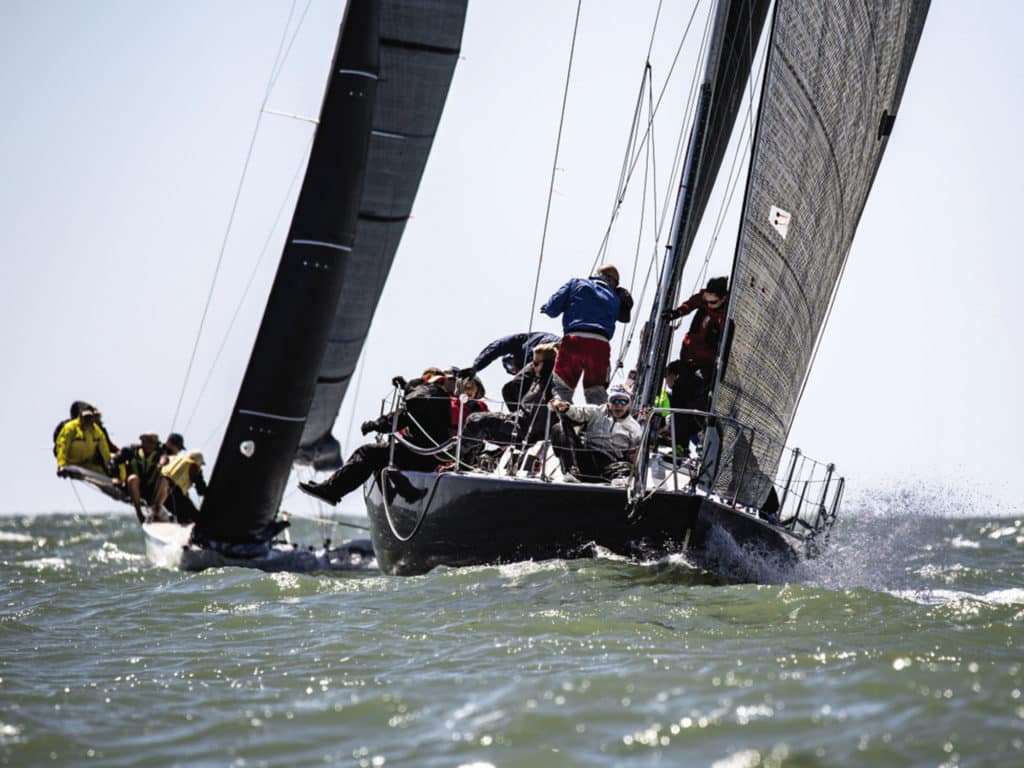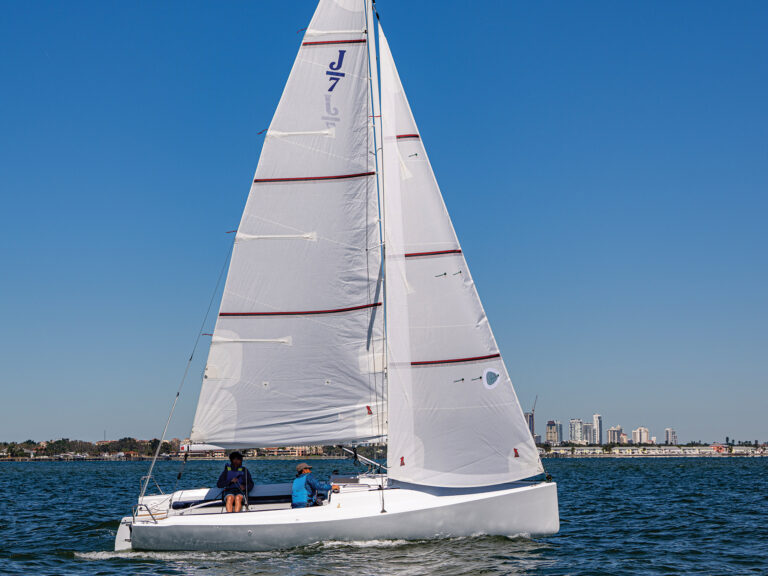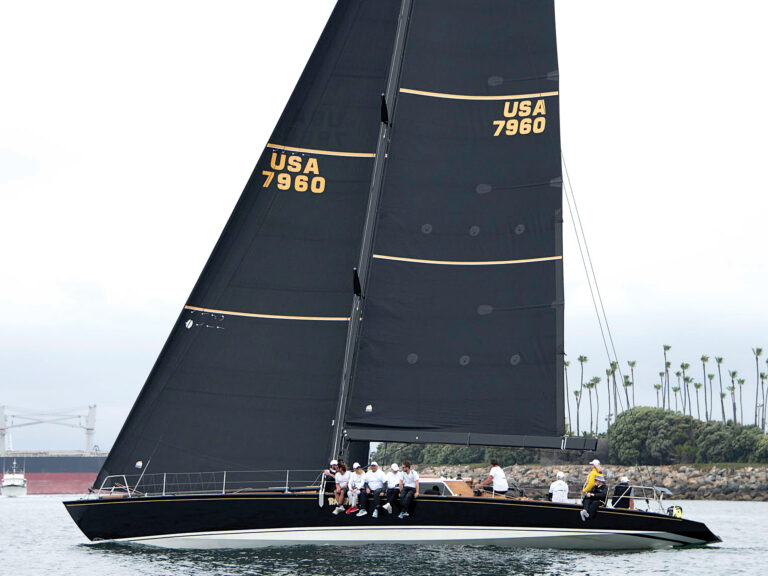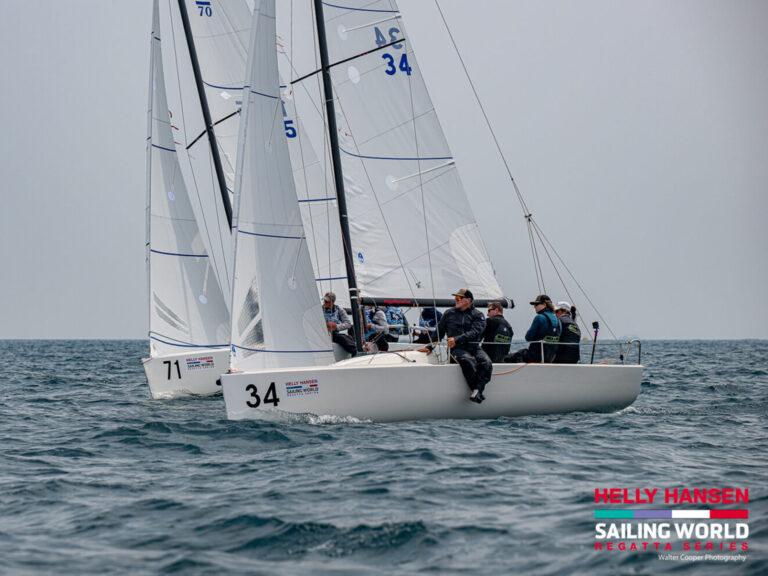
The day was perfect for racing. With the wind out of the south at 15 knots, there was a spirited group of sailors striving to get their yachts to the finish line without leaving a second to spare on the racecourse. The course was a standard windward-leeward configuration, with 1.6-mile legs. After a below-average finish in the first race, our crew refocused and sailed exceptionally well for the next five races, achieving great starts, sailing on every favorable wind shift, and executing our boat handling with deft precision. We were doing everything we possibly could to ensure a corrected-time win.
But then, to our dismay, we watched our rivals round the final weather mark from well behind, set their spinnakers and jump on plane, cruising through our lee and sailing away, easily saving their time allowances and beating us on corrected time. Afterward, we analyzed every detail of every race, searching for ways to save even more time. Maybe we could have gained 20 seconds, but it never added up enough to make a difference. Eventually, it became clear to me that the handicap rating rule wasn’t working properly—certainly not for us, nor many other owners and teams that are becoming disheartened with the state of big-boat handicap racing.
This is, of course, not a new problem. The quest to assign fair handicap ratings to yachts of different shapes and sizes has been a challenge for more than a century. Looking back, a pattern seems to repeat every 20 years or so: A new rule emerges, designers and owners attempt to exploit every conceivable loophole, and inevitably the fleet dwindles as sailors become dissatisfied with the rule and walk away.
Big-boat handicap racing in North America is at a turning point once again. During my tenure at World Sailing, I was liaison to the Offshore and Oceanic Committee and the Offshore Racing Council. At US Sailing, I pushed the organization to improve its offshore regulatory operations. My perspectives, as a competitor and a board member, have always been aligned. In the United States, there is general dissatisfaction with our handicap rating rules, but what I have learned from current leaders about this situation is that help—and change—is on the way. To be successful, bold steps are in order.
Now, however, is not the time to create a new handicap rating rule. All the experts I’ve spoken to agree the preferred action is to improve the entry-level Performance Handicap Rating Factor system and work with the Offshore Racing Council, which manages ORC, to improve its rule for North American racing sailors. Creating a new handicap rule is an arduous process, and success is not a sure thing. There are many lessons from the past: In 1965, the Cruising Club of America and the Royal Ocean Racing Club collaborated on a new handicap rule for use in the Olympic Games. The Offshore Racing Council was formed to administer the new International Offshore Rule in 1969.
IOR was a vibrant rule because it was universally accepted and used internationally. In time, however, favor in IOR started to fade. Stan Honey, an authority on offshore racing and handicap systems, says American sailors became frustrated with the ORC in the 1980s for not fixing known problems with IOR. “ORC did not have the strength of character to maintain the IOR rule,” Honey says. “The technical committee was comprised of designers that had their own boats in build, so those guys didn’t want to change the rule to fix the problems.”
The IOR’s problem children—yachts with pinched ends—eventually killed the rule.
“The IOR would still be working if the ORC had fixed it,” Honey says, “but they didn’t. The boats got weird, and nobody liked them anymore.”
US yachtsmen then went and funded the development of the H. Irving Pratt Project and created a velocity prediction program (VPP) that became the Measurement Handicap Rule. The Pratt VPP is still the basis for handicapping rules in use today. The ORC used the basics of the MHS rule and created the International Measurement System, and soon enough, the same problems surfaced again.
“The ORC screwed it up again because it did not maintain it even though there was some great racing with the IMS rule,” Honey says. “When the loopholes got figured out, the technical committee did not fix the problems. So, the United States split off again, creating the Americap Rule and the Offshore Rating Rule.”
Today, several handicap rating rules are used in North America, including ORR, ORC, IRC (which is owned by the Royal Ocean Racing Club) and PHRF. That’s too many, and none are perfect.
Ed Cesare, chairman of New York YC’s Handicap Rating Rule and Measurement Committee, says the club used ORC broadly last summer for the first time and experienced a high level of disappointment from the fleet. “We received complaints about the quality and integrity of the certificates,” he says. “I am not at all comfortable that we are going to get to a good place with the ORC rule. They did a good job on marketing it, which led to unrealistic expectations about what the rule can do.”
Cesare and Larry Fox, representing the Storm Trysail Club, presented seven submissions via US Sailing to the ORC. The submissions asked to expand the wind range down to 4 knots; define the allowable use of unusual headsails (Code Zeros); and improve the way the VPP handles planing boats, adding more wind ranges from three groups to five. They also asked stability calculation questions, including a request to allow multiple standard ORC certificates at once for the same boat, and a request to examine the rated performance of unique boat types.
“All of [the submissions] were remanded to the technical committee,” he says.
The ORC’s response was the same when the United States was complaining about IOR and IMS in the 1980s and 1990s, Honey says. “It does not end well when you take that approach with American sailors.”
The ORC, he adds, needs to aggressively work to solve the problems and come up with a better rule, or at least a version of the rule that meets the needs of US sailors. “For 2022, the five wind-band scoring will help,” he says. “We think this will ameliorate the displacement-planing situation. It is in progress, and I hope the ORC will work with us.”
The United States has the third-highest number of ORC International certificates, so Cesare says his group will take action by putting yachts in appropriate classes. “The class breaks are going to be draconian,” he says. “If you have a 40-foot planing boat, you better get some of your friends to come or you are going to be racing by yourself.”
Dobbs Davis, chair of the ORC Promotion and Development Committee, has been championing the rule for many years. He is, of course, an enthusiastic supporter of the rule and says it works if the scoring is done properly. “Using ORC tools, we have multiple ways of scoring,” Davis says. “One of them is the wind triple-number system—low, medium and high [wind strength]. There are crossovers, which puts a burden on the race committee because they have to decide what is the low, medium or heavy wind. Basically, below 8 knots is low, 9 to 14 knots is medium, and above 14 knots is high.”
As far as dealing with the concerns of Cesare and Fox, Davis says the scoring works fine with planing boats—again, as long as the scoring is done properly. As to US Sailing’s other submissions, Davis says, race committees do need to establish accurate wind strengths to score boats correctly, but this is not easy. Some race committees will determine the wind strength before the race starts, and scoring with five wind ranges will make it worse. The ORC will not allow boats to have multiple certificates, he adds, “which would make it tough on our administrators. The ORC will not make estimates on stability. This is a safety issue.”
Matt Gallagher, an ORC member, past chair of the Chicago YC’s Race to Mackinac, and chair of US Sailing’s Offshore Racing Committee, says he’s committed to achieving two goals: “We want our members and racers to go offshore and do it with any rating rule our partner clubs choose to use, and then bring some stability to the rating rules and bring some focus back to PHRF. The base of the pyramid has been neglected for a while. We have to start growing that again.”
Gallagher is optimistic about the use of the ORC rule and says it’s one that needs attention and tweaking to make it more appropriate for the United States. “[The ORC is] going to have to pay more attention to us.”
Honey agrees: “PHRF should be cheap, cheerful and simple scoring,” he says. “People should understand that the most effective rating for their boat is in class scoring. Anything that changes a boat out of class scoring is going to be punished [with a higher handicap rating]. If you want to spend more money to perform better, put your money in new sails, coaches, a smooth bottom and stuff like that.”
As for the future, Honey has an interesting prediction: “A new rule will happen. The original VPP that came out of the Pratt Project is still the basis for the ORC. It is long in the tooth and old-fashioned. What is going to happen next is some graduate students are going to come up with some neural network-based rule. The timing will be just right in a year or two because people will be really frustrated with the ORC. It will start another 15- to 20-year cycle until people get tired of that rule.”
Until then, he says, US Sailing must focus on providing high-quality measurement services and supporting PHRF by providing a first-class online database with regional ratings and guidelines to help race committees manage local fleets. “PHRF should be kept at the entry level and use single time-on-time scoring,” Honey says. “Any event that wants to do wind-condition scoring should move on to another rule. Any sailor that wants to optimize their boat for different races should go do some different rule.”
A few venerable American races, such the Newport to Bermuda and the Transpacific Race, continue to use the ORR rule. However, in recent years, the Offshore Racing Association, which controls ORR, has struggled to keep its operation functioning. The ORC rule has a chance to be more broadly adopted domestically, but its managers need to work with American race organizers to improve the rule. PHRF has a promising future, but would be well-served to update its operations to make it easy to use. In our age of supercomputer technology, we have the capability to make improvements to handicap rating rules.
Honey suggests improvements can be made by using direct computational fluid dynamics for both hydrodynamics and aerodynamics, which is likely to be the first major improvement. The CFD would be incorporated in the rating calculator and run for each boat from the lines files and measurements. “The technology exists now and is becoming practical as computers become more powerful,” he says. “This would be a major step forward from the VPP in use now by ORC and ORR. I think ORC and ORR are considering such a development.”
US Sailing has hired veteran handicap rating administrator Jim Teeters to oversee the offshore office, and Alan Ostfield, US Sailing’s new CEO, has committed to hiring additional personnel to help Teeters get the operation running efficiently. To assist owners through the arduous measurement process, Honey is an advocate of using the Universal Measurement System, which allows boats to be measured once, with the measurement data used for any handicap rating rule.
Sailors and handicappers clearly don’t agree on what the ideal handicapping rule should be, but every sailor does want a fair chance of winning a race if they sail well. We all need to work together to make improvements so that when the wind is right and we sail a perfect race, we can be rewarded with the win.









